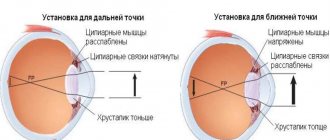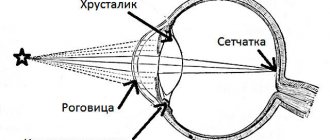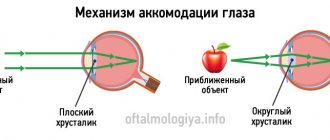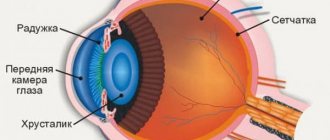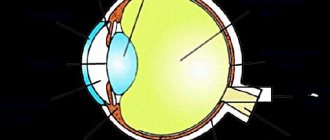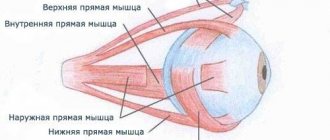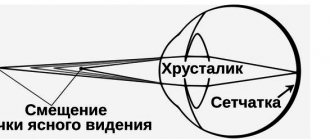Accommodation is the ability of the eye to change focal length to provide good quality vision at different distances.
The human eye is a complex optical system, which includes two lenses: the cornea, which, like the moisture in the anterior chamber, is responsible for the refraction of light rays, and the lens. In addition to them, this system also includes light-conducting structures, which include: the moisture of the posterior chamber, as well as the vitreous body. At the same time, the quality of vision is directly dependent on the characteristics of the refraction of light rays and their transmission to the retina.
Accommodation provides the ability to see objects that are located at a distance, at an intermediate distance and near.
The work of the eye fully corresponds to the daily needs of a person. This ability is precisely accomplished by accommodation.
Accommodation mechanism
Accommodation occurs due to changes in the shape of the lens. When a person looks into the distance, the ciliary muscle begins to relax, and the ligament of Zinn, on the contrary, tenses, stretching the lens capsule. The elongated shape of the lens reduces the refractive power of the eye, allowing light rays to be accurately focused on the retina and providing good distance vision.
The work of accommodation causes tension in the ciliary muscle and relaxation of the ligament of zinc, while the elastic lens becomes more convex in shape. This creates conditions for focusing images of objects that are at close range on the retina.
Two divisions of the autonomic nervous system take part in accommodation - the sympathetic and parasympathetic. In this case, the leading role in the work of the ciliary muscle belongs to the parasympathetic department. The sympathetic department of the nervous system is responsible for the metabolic processes taking place in the ciliary muscle, to a certain extent, counteracting its contraction.
The accommodation process is the main mechanism that provides the so-called dynamic refraction. This refraction is characterized by clear focusing of images of objects that are located at different distances from the retina. For example, in the case of insufficient curvature of the lens, and the absence of a clear focus of the object on the retina, information about the blurred image is received in the central parts of the nervous system. The nervous system, at the same time, sends a corresponding signal to the ciliary muscle, the work of which changes the refraction of the lens. At the moment when the images on the retina become clear, stimulation of the ciliary body immediately stops.
With maximum relaxation of accommodation, vision is set to the farthest point of clear vision, gradual tension of accommodation to the maximum sets vision to the nearest point of clear vision of a person.
The distance between the closest and farthest points of clear vision is usually called the area of accommodation. It is especially large in people who have normal refractive power of the eye - emmetropes, as well as in farsighted people. With emmetropia, the eye, in a relaxed state, looks at infinity, while at maximum tension it looks at an object located very close.
With farsightedness, when looking into the distance, tension in the ciliary muscle occurs, equal to the degree of farsightedness, which can increase even more when a person looks at nearby objects. In myopic people, the ability to accommodate is underdeveloped and the eye is able to see well only at a short distance, and the higher the degree of myopia, the shorter this distance. Being in complete darkness, the human ciliary muscle is in a state of full readiness and maintains slight tension.
With age, the accommodative capabilities of the eye decrease. Usually, this is associated with developing presbyopia (age-related farsightedness), which causes a gradual weakening of accommodation, due to which the quality of vision at close distances decreases. As a rule, such problems begin after 40 years of age, and slowly progress until the age of 60, after which this progression stops. These changes are caused by changes in the ciliary muscle and compaction of the lens, with a decrease in its elasticity. With existing farsightedness, the described changes occur earlier. But if a person has myopia, the value of which is 3 diopters or higher, age-related manifestations of presbyopia, as a rule, are completely absent.
Correction of manifestations of presbyopia occurs by selecting glasses for working at close range, which must correspond to the degree of insufficiency of accommodation.
Accommodation indicators
The accommodative ability of the eye is expressed in diopters or linear values.
- Functional rest of accommodation is the absence of an accommodative stimulus in the visual field.
- The area of accommodation is the distance between the farthest (distance vision) and the nearest (near vision) points of clear vision.
- The volume of accommodation is the difference in the refractive index of the eye (in diopters) when set to the nearest and farthest points of clear vision.
Absolute volume (monocular) - the difference between maximum dynamic and static refraction, examined when the second eye is turned off. The volume of relative accommodation characterizes the possible range of changes in the tension of the ciliary muscle during binocular fixation of an object. There are positive and negative parts of the volume of relative accommodation - they are judged accordingly by the maximum minus or plus lenses, when used at a distance of 33 cm (the average working distance for near) the clarity of vision of the text is still preserved. - reserve is the unused part of the accommodation volume (in diopters) when the eye is positioned at the fixation point.
Accommodation indicators obtained from examining each eye separately are called absolute. And both of them are relative at once, because are performed with a certain convergence (reduction) of the visual axes.
Accommodation is closely related to convergence. At the same angle of convergence of visual lines, the accommodation costs in patients with different visual acuities are not the same. For example, children with uncorrected hyperopia (farsightedness) of moderate and high degree may develop accommodative convergent strabismus.
Symptoms of accommodation disorders
- Insufficient accommodation for near.
- Insufficient accommodation for distance.
- False myopia is a spasm of accommodation.
- Paralysis of the ciliary muscle is paralysis of accommodation.
- Presbyopia.
In the medical department, everyone can undergo examination using the most modern diagnostic equipment, and based on the results, receive advice from a highly qualified specialist. The clinic is open seven days a week and operates daily from 9 a.m. to 9 p.m. Our specialists will help identify the cause of vision loss and provide competent treatment for identified pathologies.
You can make an appointment at the Moscow Eye Clinic by calling Moscow 8 (daily from 9:00 to 21:00) or using the online registration form.
Dagaev Adam Huseinovich
Introduction. Adaptation and accommodation
The term "adaptation" came into fashion with Darwin's theory of the origin of species by natural selection. This theory was based on the observation that no two members of a species or family can be found exactly alike. Everywhere we encounter variability and uniqueness. Darwinian theory took this variation and explained species as the result of natural selection. Individuals best adapted to life in the conditions provided by the environment survived and produced the existing species. Others died, and the species they represented disappeared. The differences between these species were explained as the result of the accumulation and continuation of individual changes that had “survival value.” Adaptations were the changes that were thus selected and transmitted.
* Translated from: Park R. Accomodation // Introduction to the Science of Sociology / Ed. by R. Park and E. Burgess. Chicago, L.: Chicago Univ. Press, 1969, pp. 663-670.
The term "accommodation" is a related concept, but slightly different in meaning. The difference is that adaptation applies to organic modifications transmitted biologically; whereas accommodation applies to changes in habits that are or can be transmitted sociologically, that is, in the form of social tradition. The term was first used in this sense by Baldwin in his Dictionary of Philosophy and Psychology.
From the point of view of modern biological theory, two types of adaptation should be distinguished: a) adaptation through change (hereditary); b) adaptation through modification (acquired). For the functional adaptation of an individual to his environment (see paragraph b), Mark Baldwin proposed the concept of “accommodation,” suggesting that adaptation would be linked to structural adaptation, general and hereditary (see paragraph a). The concept of accommodation is applicable to any acquired change in function that promotes better adaptation to the environment and subsequent functional changes.
The concept of accommodation, having a limited scope in biology, has been widely and variedly used in sociology. All social heritage, traditions, feelings, culture, technology are accommodations, that is, acquired adaptations transmitted socially and not biologically. They are not part of the individual's racial heritage, but are acquired by the individual through his social experience. These two concepts also differ in that adaptation is the result of competition, and accommodation (or more precisely, social accommodation) is the result of conflict.
The result of adaptation and accommodation, supported by the struggle for existence, is a state of relative equilibrium among competing species and their individual representatives. This balance established by adaptation is biological; this means that it will be transmitted by biological inheritance, so far as it is continuous and fixed in a race or species.
However, equilibrium based on accommodation is not biological; it is economic and social in nature and is transmitted, if at all, by tradition. The nature of the economic equilibrium established in the course of competition was presented quite fully in Chapter. VIII. The plant community is balance in its absolute form.
In animal and human societies, the community may be said to have become part of the individual members of the group. Individuals are adapted to a special type of communal life, and these adaptations in the animal community, in contrast to the human community, are represented by the division of labor between the sexes, instincts that ensure the protection and well-being of the young, and all this is transmitted biologically. Human society, although it allows for the expression of these original tendencies, is organized around traditions, customs, collective representations, in short, around consensus.
And consent does not represent biological adaptations, but social accommodations.
Social organization, with the exception of an order based on competition and adaptation, is essentially an accommodation of differences achieved through conflict. This fact explains why it is diversity of opinion, and not unanimity, that is a characteristic feature of the human community, in contrast to the animal one. Professor Cooley formulates this position quite clearly: “The unity of social reason lies not in the contract, but in the organization, in the fact that its constituent parts mutually determine each other and thanks to this everything that happens in it is connected with everything else, and in this is the sum of the whole.”3
The difference between accommodation and assimilation can be illustrated by the difference between domestication and domestication. Through domestication and breeding, man has changed the original heritable traits of plants and animals. He changed the nature of the species. When individual members of a species, naturally in conflict with man, are domesticated, they become accommodated to him. Eugenics can be viewed as a program of biological adaptation of the human race in the course of the conscious implementation of social ideals. Education, in turn, is a program of accommodation, or the organization, modification and culture of original traits.
Any society is an organization of elements, more or less antagonistic in relation to each other, but united for some time, at least in such a way that the mutual relations and corresponding spheres of action of each are defined; from elements. This accommodation, this modus vivendi*,
may be relatively permanent, as in a society consisting of castes, or a transitional state, as in a society consisting of classes. In any case, accommodation, as long as it persists, provides the individual or group with recognized status.
* Way of existence. — Approx. ed.
Accommodation is a natural outcome of conflicts. In accommodation, the antagonism of hostile elements is regulated at the moment, and conflict as an open, obvious action disappears, although it remains as a potential force. As the situation changes, the adaptation that has successfully controlled the antagonistic forces until now no longer works. Confusion and unrest begin, which can turn into open conflict. Conflict, whether war, strike, or simply the exchange of polite insinuations, invariably ends in a new accommodation, or social order, which generally includes a changed status in the relations between the parties [to the conflict]. And only assimilation completely erases this antagonism hidden in the organization of groups or individuals. ,
ACCOMMODATION
ACCOMMODATION (from Latin accomodatio - adaptation) in biology and medicine, a term traditionally used in the following cases. A. lens, adaptation of the eye to clearly seeing objects located at different distances by focusing the image on the retina. In fish, the eye is set to close vision, and A. is achieved by moving the spherical lens back. In amphibians and reptiles, the eyes at rest are set to distant vision, and vision is achieved by moving the lens forward using a special lens. muscles. In birds, mammals and humans, when A. changes in the curvature of the lens, that is, the refractive power. This is achieved with the help of the ciliary body, the contraction or relaxation of the fibers of which leads to relaxation or tension of the zonules of Zinn, which are responsible for changing the curvature of the lens. In addition, the ability of the lens to A. means. to a certain extent determined by its elasticity.
In humans, A. of the eye is the main. dynamic mechanism refraction of the eye. When viewing an object at close range, due to its unclear image on the retina, signals are sent to the brain. Excitation with oculomotor. The nerve is transmitted to the ciliary muscle, which contracts, due to which the ring of the ciliary body narrows, the tension of the ligament of Zinn weakens and the lens, especially its anterior surface, becomes more convex. The refractive power of the eye increases, and the image of a close object becomes clear. When the visual axis of the eye is transferred to a distant object, irritation causes ocular movement. the nerve stops, the ciliary muscle relaxes, the ciliary body ring expands, the ligament of cinnamon tightens and the lens takes on a flatter shape.
A. the eyes control the parasympathetic. and cute. nervous systems. To study A. the eyes, special ones are used. optical instruments (optometers, refractometers).
Presbyopia is one of the age-related changes in the eye. Violations of the A. lens can also occur as a result of prolonged eye strain, eye injuries, exposure to bright light and other influences that cause spasm of the accommodative muscle, and with some infections or intoxications (syphilis, influenza, diphtheria, botulism, etc.) her paralysis occurs.
A. physiological - the process of adaptation of excitable tissues (muscle and nervous) to the action of a stimulus that slowly increases in strength. The slower the strength of the stimulus increases, the more the irritation thresholds increase. An isolated nerve fiber, for example, cannot be excited at all with a slow increase in the stimulating current.
